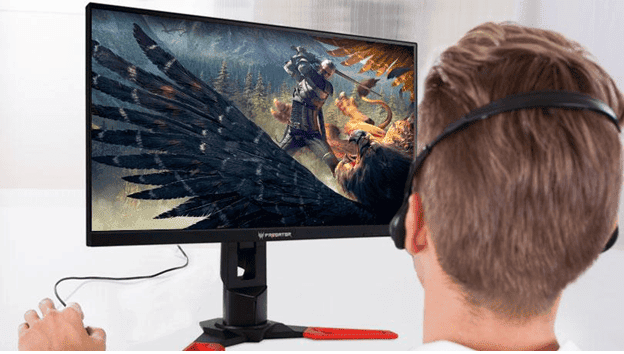If you are an avid gamer or you are looking to get a set up that is ready for gaming at a higher level, you will want the right monitor to do the job. If a gaming set up is new to you or you have been using your TV as your monitor, then there are some key things you need to consider before you make the purchase.
One of the things to realise is that gaming monitors and regular monitors are not the same thing. So, how does this affect you? Don’t worry we’re here to give you the run down.
Key Features
When you are looking at a gaming monitor, bigger is better when it comes to the specifications that are available. Here we are specifically talking about refresh rate and pixels per square inch.
The higher these numbers, the better your images will look on the screen. Regular monitors have a refresh rate of around 60 Hz, which is often the base line refresh rate for LED monitors and TV’s.
When you are looking at a gaming monitor, you want to make sure that the refresh rate is 120Hz, this means that the screen refreshes at 120 times a second, making the image smoother, especially in fast paced gaming.
If you use a traditional monitor when you game, especially if you are an avid first-person shooter gamer, you will see a noticeable difference if you upgrade.
Console Gaming vs PC Gaming
If you are using a console to game, there isn’t much point in purchasing a gaming monitor to plug it into. Gaming consoles lag behind gaming PC’s with their hardware and graphics capabilities at this present time, so there is little point in buying a dedicated gaming monitor with a high refresh rate.
You can get your hands on a regular 4k system with a low refresh rate (around 60hz), this will make your gaming look better, but you can also enjoy the screen or monitor to watch films on. 4K is considered the true successor to 1080p and the cost of the upgrade is relatively small.
If you are gaming on a PC, then a good upgrade from you 1080p monitor will be a 1440p 144hz gaming monitor. It provides you with an excellent refresh rate and the technological advances in this monitor type also reduce the blurriness that gamers often complain about when using lower powered monitors.
The only thing you will need to bear in mind is that if you are looking to use this type of monitor, you may well need to consider upgrading some of your hardware so that you get the best out of it.
Monitor Size
When it comes to gaming monitors, you have a goldilocks zone which is between 24 and 27 inches. Any bigger than that and you will find that you lose picture quality.
With regular monitors, you can go larger and have a wider screen, but this is only practical if you aren’t a serious gamer and will be using the screen for other things. The biggest obstacle to monitor size is the computing power that your gaming rig has.
If you want a super crisp, incredible picture on a 30-inch gaming monitor, you will need to make sure that you have the associated graphics card installed. Upgrading hardware in a gaming system isn’t cheap and this will need to be factored in if you are building a system from the ground up.
You can get middle range graphics card and a good 1440p monitor that will provide you with good quality images and a good refresh rate if you don’t want to be spending out a fortune.
Really, It Comes Down To You
When it comes to choosing a monitor, be it for gaming or regular use, it comes down to your own personal preference and situation.
Regular monitors are excellent if you are playing on a console, as they are not capable of handling higher refresh rates, as of yet.
If you are using a gaming PC, then look to get the best monitor you can afford with the highest level of specifications that your graphics cards and other internals can handle.
Final Thoughts
When it comes to gaming monitors, the key factor to be looking at is the refresh rate, the higher this number, the faster the images will change on the screen.
Regular monitors have lower refresh rates and lower specifications, but unless you are an avid gamer or wanting to go professional, you may not want to invest your extra cash in something you don’t use very often.
The higher the specifications, the more hardware you will need to be able to the monitor effectively, so really, it comes down to how you game and what you want to be able to do.







